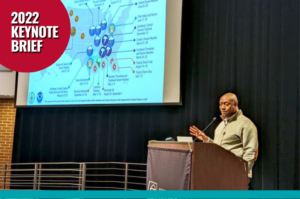By Megan Farrer
 The technology cooling the device you’re reading this on may someday be used to cool cities, redistributing and repurposing heat from the hottest urban areas.
The technology cooling the device you’re reading this on may someday be used to cool cities, redistributing and repurposing heat from the hottest urban areas.
That’s one current project atmospheric sciences expert Marshall Shepherd is exploring to combat the impacts of climate change on communities.
Heat transfer technology may seem a strange topic to share in a keynote presentation at the 2022 State of the Public’s Health Conference, but it exemplifies the types of interdisciplinary research projects and diverse teams that are tackling the intertwined issues of climate change, extreme weather and public health disparities.
According to Shepherd, who is the Georgia Athletic Association Distinguished Professor of Geography and Atmospheric Sciences at the University of Georgia, cities are a specific nexus of climate change and health due to “urban heat islands,” locations where things like pavement, lack of trees and waste heat create spaces that are hotter.
This extra heat means increased energy costs for residents, air pollution and health risks like heat-related illness and death.
Urban heat islands are one symptom of human-caused climate change. A warming planet also increases the number of weather events like hurricanes and even snowstorms that can disable infrastructure like healthcare systems, water, power and roads. And this increase in frequency is not trivial, especially when looking at 2022’s severe weather events.
“We’re into October and we’re already at 15 events,” Shepherd said. “These numbers are significant, and they continue to increase every year.”
Beyond extreme weather events, a warmer climate spells other changes that have significant public health implications. Among these changes are increased allergens, forced human migration, degraded living conditions, water and food-related issues and shifts in how infectious diseases in animals spill over into human populations.
“There are mosquitos that can thrive here in the contiguous United States that 30 years ago could not. You only found them in tropical places,” said Shepherd.
One of Shepherd’s research objectives is to illuminate the processes connecting climate change, extreme weather, and the populations that experience their worst effects: a concept he’s named the “Extreme Weather-Climate Gap.”
Shepherd focuses on two specific aspects of weather-climate experiences: risk and resilience. The “gap” in “Weather-Climate Gap” refers to a disproportionate sensitivity to extreme weather-climate events in certain communities, and a delay in their ability to bounce back.
“Now as I scan the room, I would imagine that if we all lived in a coastal community and there was a hurricane like Ian approaching, I think most of us probably have the economic capacity to take our families and perhaps go to Atlanta to get away – and insurance to withstand damage,” Shepherd said. “A lot of people don’t have either of those options.”
The ways that individuals and communities experience the symptoms of climate change are affected by existing geographic, racial and economic inequalities, he explained. Those who live in vulnerable places and don’t have the resources to “bounce back” after extreme whether events tend to experience increased rates of illness and mortality as a result.
Shepherd stressed the importance of understanding the connections between climate and public health as a path toward a more just future as we navigate what he calls the “new normal” of more extreme weather.
So while the connection between the cooling technology in your devices and urban mortality rates might not be immediately clear, it’s these types of big ideas and diverse collaborations that Shepherd sees as hopeful.
